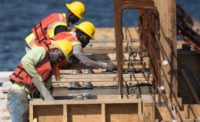
Global warming and climate change, subjects we generally don’t discuss in polite company or with fossil-fuel industry clients, are in the news again.
A U.N. panel’s just-issued report on impacts of global warming 1.5° C above pre-industrial levels—the limit set in the 2015 Paris agreement—has a strong warning: If sharp cuts in greenhouse gas (GHG) emissions aren’t made by 2030, it is essentially game over for many ecological systems and large population sectors. Many coastal communities will be under water. Heat waves, droughts and forest fires will become more frequent.
Before this report by the Intergovernmental Panel on Climate Change, the generally-accepted target date was 2050—soon enough for a sense of urgency but far enough away to postpone serious action. Now it’s only 12 years off.
If nations aren’t in lockstep to make emissions cuts now, there is little chance to stay within the warming target. The report says at 1.5° C and below (we’re now at 0.8° C), climate-change mitigation and adaptation can be managed. Above that, conditions get really dicey, and fixes are really expensive.
Major GHG sources are in transportation, power and industrial sectors—our clients.
Different Approach
As engineers who plan, design, build and operate facilities and infrastructure that produce emissions, we are part of the problem. Clearly, we should be part of the solution. What an opportunity!
We must overhaul our engineering industry with new standards, processes and methods to radically cut GHG emissions and protect communities, facilities and infrastructure from devastating climate impacts.
We can build or rebuild transportation and energy systems. We can protect or relocate cities and towns out of harm’s way. We have the technological chops. We know what works and what doesn’t. Let’s do it!
In my naïveté, I thought engineers would jump at the chance to get involved. But response has been, at best sluggish, and at worst, it’s denial.
We keep doing what we’ve always done: respond to proposal requests, do what the contract says and position for the next job. Overwhelming scientific evidence of climate change? So what. All we care about is what’s in our scope of work.
How did engineering work get this way? Oddly enough, the answer is stationarity, an obscure but foundational civil engineering assumption about how the world works.
Engineers have always assumed, successfully until recently, that past environmental conditions are good predictors of future ones. That assumption allowed engineers to plan, design and deliver long-lived infrastructure, confident that projects would be safe, reliable and efficient throughout their design life. It allowed them to create codes and standards which, if followed, would produce consistently good results.
Faustian Bargain
This also created a Faustian bargain between engineers and society: Give us the exclusive right to design and deliver infrastructure, and we will supply specialists indoctrinated and licensed in accepted standards and methods and liable for any deviations.
Tell us what you want, and we’ll do it at the expense of our professional souls. To us, new science is interesting but irrelevant. Innovation is doing the same stuff only faster, better, cheaper. Working outside the box targets us for claims and litigation.
This works if conditions are stationary and standards and methods still apply.
But the climate is changing in ways not readily predictable. Non-stationarity is the new normal. Long-held engineering assumptions about environmental conditions are no longer reliable, so projects may not function the way they’re supposed to and can present a significant risk to public health, safety and welfare.
As I stated in a recent New York Times letter to the editor, many of us are sick and tired of trying to convince purposefully ignorant people that the climate is changing and civil infrastructure design must change with it.
Maybe we should just go with the flow and do things as we always have done—apply old design standards and get paid for our work. When infrastructure projects fail, we fix them and get paid again. It’s a new take on the old commercial slogan: Pay me now and pay me later.
Or, we could try something different—create new standards, methods and processes needed for infrastructure to work in a changing environment.
Some already are. Olympia, Wash., has an incremental approach to deal with sea-level rise by observing trends and building preplanned responses as needed.
The Federal Highway Administration has created a vulnerability assessment and adaptation framework to help transportation agencies deal with extreme weather and climate effects. California has established the Climate-Safe Infrastructure Working Group to figure out how climate change impacts can be included in infrastructure planning, design, and implementation processes.
As engineers working in the built environment, our choices are clear: Lead, follow or get out of the way.
William A. “Bill” Wallace is president of Wallace Futures Group LLC, Wilsonville, Ore. A 2014 ENR Newsmaker as lead designer of the Envision sustainable infrastructure rating system, he can be reached at bill.wallace@wallacefutures.com.




Post a comment to this article
Report Abusive Comment